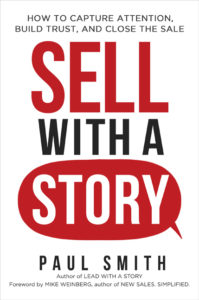Podcast: Play in new window | Download | Embed
Subscribe: RSS
Podcast (lead-with-a-story-podcast-series): Play in new window | Download | Embed
Subscribe: RSS
 Figliuolo’s Law: an individual’s compensation is inversely proportional to the number of PowerPoint slides they’ll tolerate before stroking out.
Figliuolo’s Law: an individual’s compensation is inversely proportional to the number of PowerPoint slides they’ll tolerate before stroking out.
That’s the observation of Mike Figliuolo. He’s the founder and managing partner of the executive training firm thoughtLEADERS, and the author of a new book called The Elegant Pitch: Create a Compelling Recommendation, Build Broad Support, and Get it Approved.
He’s noticed the way most people make a recommendation is to first go do a bunch of interesting analysis. Then write a thick, incomprehensible presentation deck. Present it. Then fail to persuade and wonder why.
In this week’s podcast, Mike lays out a better plan, which you can listen to by clicking the button above. And while it doesn’t do justice to our conversation, below is an excerpt from his book that can give you an overview of what that looks like.
—-
Excerpt from The Elegant Pitch (chapter 2)
The more senior an individual is, the less time they have for detailed explanations. They want the top level answer. They trust your competence; that’s why they hired you. They know if they have questions, you’ll be able to walk them through the detail. What they’re looking for when you make a pitch to them is a narrative that quickly tells them what the recommendation is, why it makes sense, and what you need to make it happen. Long presentations frustrate them.
 I worked with one CEO who used to say, “If your recommendation has a staple in it, I won’t read it.” You had to get your message across to him on a single page no matter how big the recommendation was!
I worked with one CEO who used to say, “If your recommendation has a staple in it, I won’t read it.” You had to get your message across to him on a single page no matter how big the recommendation was!
I worked with another CEO who personified Figliuolo’s Law. One day my team went in to present to him along with another team. The other team presented first. They handed him their twenty-five-page presentation. Before they even opened their mouths to speak, the CEO picked up their presentation and motioned as if he was weighing it. He then threw their slides across the room and snapped, “Talk to me! What do you want? I’m busy. I don’t have time for all this paper.”
They were surprised. We weren’t. We knew better, and our presentation was three pages long. The difference between our approach and theirs was their intent was to share everything they knew. Our intent was to share what our CEO needed to know to make a decision.
The common practice of going from data to analysis to presentation is broken. It’s an inefficient process because most of the analysis will never see the light of day. It’s wasted effort. When your meetings don’t go well because you tried to cram forty pages of content into a thirty-minute meeting, you’ve wasted everyone’s time— not only in that meeting, but also in the one you create to reconvene and discuss the idea again. Yay! Another meeting!
People who continue to use this approach lose credibility. They’re perceived as lacking executive presence because they ramble through their analyses. Their results suffer because they never get their ideas approved in the first place. This madness has to stop.
A New Approach
I’m going to ask you to do something completely backward. The structured thought process begins with the answer then works to prove or disprove it. The sequence of steps in the process is deliberate. Don’t jump ahead or do the steps out of order, or you’ll cause issues for yourself. The process is shown below.
Step 1: Define the question. You have to understand what the problem is before you can solve it. Get clarity from your requestor as to what the issue is and why they want it solved.
Step 2: Create a core idea. The core idea is your primary recommendation. It spells out the action you want to take and the rationale for taking the action. The core idea is a hypothesis as to what the recommendation could be combined with a reason for pursuing it. That reason must be something of value to your audience.
Step 3: Build the architecture. The logic of your argument is the architecture. It’s how you’re going to arrange your facts and analyses to support your core idea.
Step 4: Create the story. The story is your simple narrative that gets your audience to arrive at your conclusion. It’s derived from your architecture.
Step 5: Discuss and refine the story. This is where you get other people’s feedback on your idea. Notice you’re involving others well before you expend effort on analysis.
Step 6: Select core facts and analyses. This method isn’t about having all the facts. It’s about having the right facts. The facts and analyses you choose to do will be gathered to support your architecture.
Step 7: Prove or disprove the hypothesis. The analysis you perform is done with the purpose of proving or disproving your hypothesis. This focus on required analysis is what makes the method efficient.
Step 8: Finalize the communication. Whether you’re creating a presentation, a memo, an email, or any other document, you won’t assemble it until the process’s final stages. By the time you reach this step, your entire document is already written. This step is an exercise in assembly.
—
If you started to get a little twitchy around steps 2 or 3, relax. That’s normal. It feels strange to be selecting a recommendation and building a case for it before you’ve done your analysis. The reason it works is because you’re starting with your educated guess about the best solution (along with getting some input from your boss, your peers, your subordinates, etc.) And then you’re going to gather facts and data and test that hypothesis (i.e., do some analysis). If it proves out, you’re done. If not, then, and only then, do you move on to another hypothesis. Most of the time your first solution turns out to be the best. Turns out, you should trust your judgement more often.
If you want to improve your chances for getting your recommendations approved, grab your copy of The Elegant Pitch. If you’re interested in taking Mike’s course on the method, check out Structured Thought & Communications. He’s happy to come to your organization and teach your team how to make clearer, more compelling recommendations.
—
 Paul Smith is one of the world’s leading experts on business storytelling. He’s a keynote speaker, storytelling coach, and bestselling author of the books Lead with a Story, Parenting with a Story, and Sell with a Story.
Paul Smith is one of the world’s leading experts on business storytelling. He’s a keynote speaker, storytelling coach, and bestselling author of the books Lead with a Story, Parenting with a Story, and Sell with a Story.


 Connect with him via email here.
Connect with him via email here.
Follow him on Facebook, LinkedIn, Twitter, and Instagram.
Sign up for his newsletter here to get one new story a week delivered to your inbox.


Glad you’re enjoying it Kristin. Always thrilled to hear we have champions for the method out there in the world. I actually teach the method to clients via classroom instruction. The course is called Structured Thought & Communications (http://www.thoughtleadersllc.com/services/structured-thought-communications-foundations/). I’d love to speak with you about bringing the program into your organization. Drop me a line if you’re interested!
So much yes! Your process is similar to what I am doing at the World Bank with staff, serving them to share Stories that are compelling concise, concrete and create real impact rather than a data dump in which the listen is left recalling nearly nothing!
Excellent work and I loved that chapter! Half way through the book so far, taking it slowly and savoring! 🙂